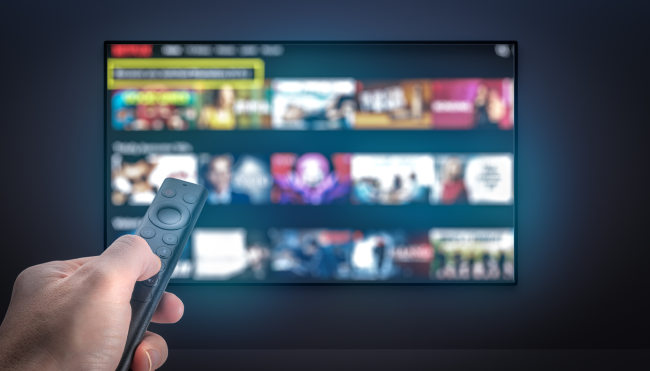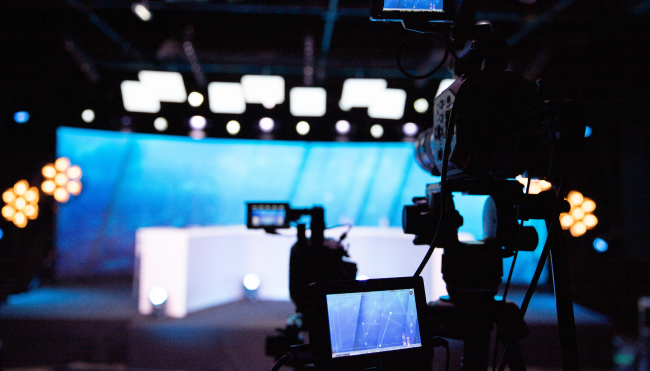- Why Amagi
-
Solutions
Contact UsBusinessWho We Serve
- Offerings
- AI
-
Resources
Contact UsINDUSTRY REPORTSAmagi FAST Report #15: The Power of Live Programming: A Catalyst for Streaming SuccessAugust 21, 2025Read More
-
Company
Contact UsNewsroomAmagi launches AI-powered Smart Scheduler to improve content programmingApril 3, 2025Read More
Blog
How to Start a Channel on TV: A Complete Guide
By Sridhar Sinnasamy, VP Sales, Amagi - March 22, 2022
Historically, if you wanted to start a TV channel, you had only two options:
- Invest millions of dollars on infrastructure and equipment to broadcast your channel on a local TV station
- Strike a deal with a cable TV company which would also require heavy startup and operational expenses (assuming they’ll even agree to deal with you)
For decades, these have been the only two routes to starting a TV channel. But, in the last few years, a new option has emerged that makes starting a channel of TV accessible to a lot more brands and individual creators: launching your TV channel online.
While local TV or cable is still the right choice for some content creators, starting a TV channel online is now the best option for most. It eliminates the need for raising capital, greatly reduces staffing costs, and makes it easier to monetize your content as effectively as possible (which is the whole point of creating a TV channel).
That said, you still need the right technology to bring your TV channel to life on as many platforms as possible. That’s where we can help.
Amagi is a cloud-based broadcast platform that helps content creators, owners, and aggregators launch, distribute, and monetize their content on online TV platforms, such as Roku, Samsung TV Plus, Pluto, and Sling TV. We also support playout on traditional cable TV channels and broadcast TV.
Since our start in 2008, we’ve helped over 500 content brands launch their channels across 40+ countries and have worked with clients like CuriosityStream, Discovery Networks, Fox Networks, Tastemade, Vice Media, and Warner Media, in addition to many more smaller creators and brands.

In this article, we’ll explain the four steps to start a channel on TV and how Amagi can streamline your experience:
- Evaluate the content you have
- Determine the type of TV channel you want to broadcast your content on
- Deliver the content to the end-user platform
- Monetize the channel with dynamic ad insertion
If, after reading this article, you’re ready to launch a linear TV channel, we can help. We currently manage over 2000 channel deliveries at a significant cost savings over traditional methods. Contact our team to discuss how to launch your channel and distribute your content to as many platforms as possible.

Step 1: Evaluate your content
The first step in creating a TV channel is understanding how your audience and viewers will relate to your streaming content. Most creators already have a clear understanding of what they have to offer, so this step won’t take long. If you’ve already done the background work here, skip to Step 2.
Before you can answer the main question of Step 2 (choosing which type of TV channel to start), you should be able to answer the following questions:
- How many hours of content do you have?
- What type of content is it?
- How does your audience prefer to consume this content?
- What platforms are they already using?
- Do you plan to offer any of your content via live streaming?
Question 1 & 2: How many hours of content do you have and what type of content is it?
The number of hours and type of content you have determine whether you have enough to run a linear TV channel or if you should instead pivot to a video on demand (VOD) experience.
For example, 60 hours of soft, soothing music with nature footage is enough for a linear TV channel because most users play it in the background. If it loops every week, most of them won’t mind.
On the other hand, viewers won’t enjoy sixty repeating hours of a cooking show, so it won’t perform well on linear TV.
Many of our clients have thousands of hours of content; if that is the case for you, linear TV is clearly a good choice. If you have less content, that doesn’t mean you can’t start a linear TV channel; it just means you need to be more careful making your program schedule and choosing which platforms you distribute it to.
Questions 3 & 4: How does your audience prefer to consume this content and what platforms are they already using?
A linear TV channel caters to the traditional “lean-back” TV experience as contrasted to the “lean-forward” experience of video-on-demand. VOD popularity is at its peak right now, but linear TV use is also surging on free ad-supported streaming TV (FAST) platforms like Roku, Samsung TV Plus, Vizio, Hulu, and more.
|
Lean-back experience (linear) |
Lean-forward experience (VOD) |
|
This is the classic system of watching TV (also called linear TV). Viewers sit back and watch the scheduled programs running on their chosen platform. They can switch between channels, but there’s no option to pause or forward (unless they’re using DVR technology). Some examples are Pluto TV and Samsung TV Plus. |
Video-on-demand (VOD) allows viewers to discover and select content they want to watch on services like Netflix or Amazon Prime from any device (e.g., phone, laptop, or TV). Here, viewers have a choice to select from any of the content options available, with the option to pause, forward, or rewind. |
Do you know if your audience prefers to consume your content through regularly scheduled programming or by binging your whole offering? Depending on your answer, you can choose to start a linear TV channel, a VOD channel, or both.
If you have any demographics or usage data that indicates which platforms your audience is already using, that will also help you plan distribution. For example, if you know that your audience is highly localized, then starting a channel on your local TV or finding a local online platform might be the best place to start.
Question 5: Do you plan to offer any of your content via live streaming?
If you have live content, then you’ll need to choose a technical solution that can support live broadcast playout. Amagi is the only cloud playout provider that can handle broadcast-grade playout for content like live news and sports. Learn more here.
Step 2: Decide which type of TV channel to start

There are four types of TV channels you can start:
- A local broadcast TV channel
- A cable channel
- Your own TV app
- A channel on an existing FAST platform
If you already know what type of TV channel you want to start, skip to Step 3.
#1. Local broadcast
Running your own TV station requires millions of dollars of investment, massive technical infrastructure, and in most countries, a license for broadcast (For example, in the U.S., you need a license from the Federal Communications Commission or FCC.) You will likely need a consultant to guide you through local market analysis.
You’ll also need a large team with appropriate technical training to manage the broadcast.
For most content creators, establishing a local TV channel isn’t feasible. And even if it is, the costs involved often don’t justify the undertaking compared to FAST. That said, running a local broadcast is far more affordable with Amagi. You don't need to spend millions of dollars in investments because we handle playout for you.
#2. Cable channels/Traditional MVPDs (Multichannel Video Programming Distributors)
MVPDs deliver several channels as a package to subscribers through cable television or satellites. Some examples of MVPDs include DISH, Comcast, DirecTV, and Cox.
First, as a content creator, you need to strike a deal with the cable company. You must have very high quality content to be considered, in most cases. And even if you succeed in making a deal with a cable company, you still have to handle all technological issues yourself to deliver the content to them.
Second, though cable TV does still generate good revenue from ads, their market share is dropping rapidly. Most advertisers are now moving online. (They spent over $14 billion on connected TV in 2021, an increase of nearly 60% over the previous year.)
While cable or satellite tv channels can still be a good option, they’re usually only viable for large media companies with a presence on multiple platforms.
#3. Creating your own app
Platforms like Fire TV App or Roku TV app let you build apps for your own TV channels.
It’s a good option if you already have an audience. (For example, you may have an audience on a YouTube channel and then create an app for them.) But, you will have to keep building your audience once your app is created. You’ll also bear the cost of hiring developers to build and maintain the app for you, plus the cost of video hosting.
For example, television networks CondeNast and Tastemade first started on YouTube. After they attracted millions of viewers, they created their own app to host their TV channel.
#4. Free Ad-Supported Streaming TV (FAST) on existing platforms or apps
FAST services support linear, live, and on-demand channels. They can run on multiple devices like smartphones, tablets, laptops, and TVs. FAST is a type of OTT (over-the-top) TV because it is delivered via the internet instead of cable or a broadcast signal. Some examples of the FAST providers we work with include Roku, Vizio, Sling, Xumo, Fubo TV, Plex, Hulu, Twitch, Samsung TV Plus, and more.
FAST is usually the best option for content creators who have digital assets on platforms like YouTube, are already earning revenue from those platforms, and are confident that their video content will perform well on TV.
To create a FAST channel, you need to make an agreement with the host platform. Most of them have a screening or pre-qualifying process. They want to know that your content is relevant and interesting to their consumers.
Once you strike a deal with a FAST channel, you need a technical partner to help you create your channels for various platforms. This is where Amagi can support you.With technical partnerships with 50+ FAST platforms and over 100 AVOD and D2C platforms, Amagi is the largest FAST service provider around the globe.Contact us if you want to discuss starting a FAST channel.
That brings us to Step 3.
Step 3: Deliver content to the end-user platform

Content consumption happens on the video service platforms (VSPs) where people tune in to watch that content. Some examples include YouTube, Roku TV, and Sling TV.
Amagi helps content creators deliver their content to the end-user platform (VSPs) they have agreements with. In order to deliver and monetize content on a VSP, you need to follow their technical specifications for video formatting, metadata delivery, and more. You also need to host the content and have enough bandwidth to ensure uptime, even if you suddenly get an influx of new viewers.
If you have a small content library and only deliver your content to one or two platforms, you could handle the technical aspects of playout with a small team of proficient staff. But if you have hundreds of hours of content, or want to run your channel on more than one platform, meeting the ever-changing specifications for each platform is too burdensome for most in-house teams.
With Amagi, managing your channel is simple. You don’t need in-depth, technical expertise, and you can schedule programming for all your channels (and platforms) from one interface.
Here’s a look at how Amagi CLOUDPORT functionality makes data ingestion, content clean-up, scheduling playout, and delivering content to each VSP simple, whether you’re starting a traditional broadcast channel or pushing content to multiple FAST platforms.
Data ingestion
It doesn’t matter where you store your content. Whether it’s on a hard drive, YouTube, Vimeo, or Google Drive — if you can share it with us, we can ingest it. That includes live TV content, recorded video, audio, graphics, subtitles, and metadata.
Next, we transcode your files according to the specifications of the FAST platforms you have agreements with. In layman’s terms, that means we make your videos and metadata compatible with the software the platform uses, along with any variations needed, so that it can play out on different types of devices (Android vs Apple, laptop vs TV, and so forth).
Many playout solutions require you to transcode your own content or impose an up-charge. At Amagi, we believe in offering full technical support at no extra cost. Content ingestion is a key step in preparing any internet TV channel, so it’s bundled into our offering.

During the ingestion step, you can also add dynamic and static overlays, dynamic lower-thirds, subtitles, voice-overs, overlays, and other advanced secondary graphics to your programs. This video has more information about Amagi’s advanced dynamic graphics capabilities, if you’d like to learn more. You can also explore how we deliver customer HTML5 graphics for live sports and new channels here.
Content quality
After your content is on Amagi’s platform, we ensure quality control to spot and fix technical errors. When you transfer content to a platform, there’s a chance of small technical failures, like a suddenly blank screen or moments of audio loss. Traditionally, finding and fixing these errors was done manually. That eats up time and money and doesn’t even guarantee complete accuracy.
Additionally, not complying to content quality guidelines also attracts hefty fines from regulatory bodies. For example, for most video assets, it’s mandatory to offer closed captioning for audio-impaired audiences. But Amagi CLOUDPORT automates the entire quality control process, eliminating the time and effort you’d invest in carrying out this process on your own. Some quality control processes that we automate include:
- Normalizing frozen frames
- Detecting black frames in a playout
- Detecting loudness & audio losses (and correcting them)
- Ensuring synchrony between video and its subtitles
We also generate a low-resolution preview of each asset so that quality control teams can confirm everything’s ready to go.
Playout scheduling
You can manage programming for traditional broadcast, cable TV, and web TV channels with our simple drag-and-drop playlist scheduler. That means you create program schedules for all your channels from the same interface.

You can manage playout schedule remotely using a web browser. Here’s a quick overview of how that works:
- Amagi sources metadata from your content and displays that metadata alongside your program details. This helps you search, sort, and filter the right media to be scheduled in the calendar.
- Then, you can create a program schedule or electronic program guide (EPG) for multiple days. You can decide if you want the content to run daily, on weekends, or in any other customized pattern.
- Next, VOD and linear TV platforms receive the EPG from Amagi. The EPG provides information on both the current and scheduled shows for your channel on the user’s devices in an easy-to-consume format.
Content delivery
Once you’ve set up your playlist, Amagi streams the content directly to smart TVs, phones, tablets, or laptops through fiber, satellite, or IP-based delivery in the pre-defined format (4K Ultra HD, Dolby Atmos, etc.) required for each of these devices. Once the channel is up and running, we maintain a 99.99% uptime.
Amagi partners with platforms like Roku TV, Samsung TV Plus, Pluto, Fubo TV, Apple TV+, and others to distribute your content to over 200 million connected TV households.

Step 4: Monetize your content with dynamic ad insertion
The whole point — at least for the majority of content owners — of creating a linear TV channel is to make money from your video assets. Amagi employs dynamic ad insertion (DAI) technology to simplify the whole process of running ads, from preparing your content (adding markers like SCTE, DTMF Cue Tones, or Packet31) to inserting personalized ads for your viewers.
We can seamlessly insert personalized ads with recorded, live TV, and VOD programming. We partner with leading ad networks such as SpotX, Google DFP, Pubmatic, The Trade Desk, Telaria, and TripleLift, among others.
But we handle even more than just the technical aspects of serving ads. We also provide in-depth analytics and insights on what content performs the best, at what time, and with what audiences. That way, you can continue to increase revenue by adjusting content programming based on real data.
You can even adjust ad strategy in the moment if you notice a viewership spike, for example.
You’ll also have access to information on ad breaks, the total number of ad impressions, completion rates, and ad drops.

Keep growing your TV channels with Amagi
Apart from helping you distribute and monetize new channels, we also help you expand your reach. If we know of specific channels that your content would do well on, we’re happy to make an introduction between you and their team.
We also want to make sure that you’re able to solve the problems you come across while creating and managing your channels. While our team is always ready to help with technical issues, you can leverage our customer community for industry advice as well. For example, if you face particular scheduling challenges with a sports broadcast, we can introduce you to another content creator in the space who faced similar difficulties.
We’re also working on customer forums where a number of content creators in a related space come together to discuss common problems and how to solve them.
In short, Amagi provides both the technology and the community to help you bring your TV channel to life, whether it’s your first channel or your tenth. We’d love to chat with you about your content and how to best leverage it on linear TV platforms. Contact our team today to learn more.
Related Blogs
Get started
Increase revenue and reach with our Broadcast & Streaming solutions.
Cloud modernization. Streaming unification. Monetization. Marketplace.
 German
German French
French Spanish
Spanish Korean
Korean Japanese
Japanese Portuguese
Portuguese


